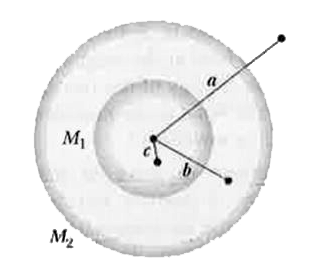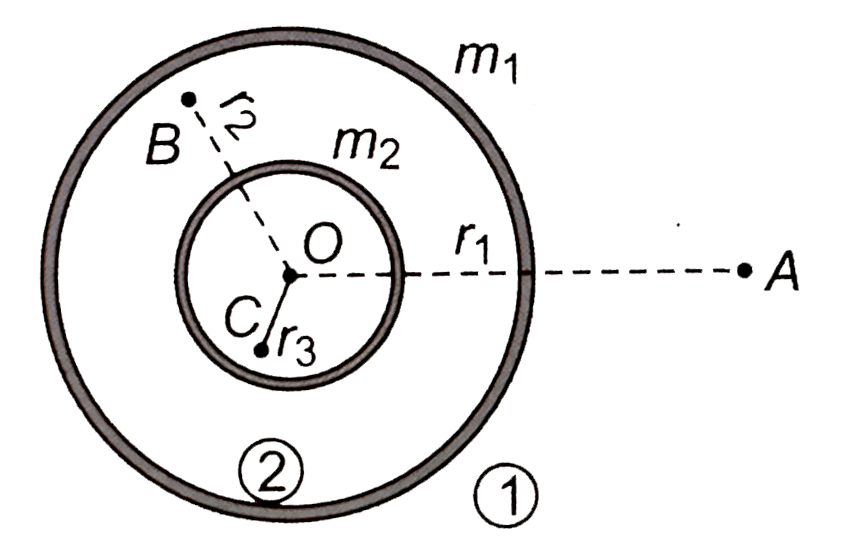Two concentric sperical shells with uniformly distributed masses are situated as shown. Find the magnitude of the net gravitational force on a particle of mass kg due to the shells, when the particle is located at radial distance (a) a = 11.0 m, (b) b = 6.00 m and (c) c = 2.00 m.

(a) (b) (c ) If the particle is at C, then no other mass is at smaller radius and thegravitatinal force onit is zero.
Topper's Solved these Questions
- BOOK - RESNICK AND HALLIDAYCHAPTER - GRAVITATIONEXERCISE - PRACTICE QUESTIONS (SINGLE CORRECT CHOICE TYPE)16videos
GRAVITATION
- BOOK - RESNICK AND HALLIDAYCHAPTER - GRAVITATIONEXERCISE - PRACTICE QUESTIONS (MORE THAN ONE CORRECT CHOICE TYPE)7videos
GRAVITATION
- BOOK - RESNICK AND HALLIDAYCHAPTER - GRAVITATIONEXERCISE - CHECKPOINT5videos
GRAVITATION
- BOOK - RESNICK AND HALLIDAYCHAPTER - GEOMETRICAL OPTICS : REFRACTIONEXERCISE - Practice questions(Integers)4videos
GEOMETRICAL OPTICS : REFRACTION
- BOOK - RESNICK AND HALLIDAYCHAPTER - HEAT-MEASUREMENT AND TRANSFEREXERCISE - PRACTICE QUESTIONS( INTEGER TYPE)5videos
HEAT-MEASUREMENT AND TRANSFER
Similar Questions
What must be the momentum of a particle with mass m so that the total energy of the particle is 4.00 times its rest energy?
View SolutionTwo concentric shells of mass m1 and m2 are situated as shown. Find the force on a particle of mass m when the particles is located at (a)r=r1,(b)r=r2,(c)r=r3. The distance r is measured from the centre of the shell.
 View Solution
View SolutionCalculate the gravitational force of attraction between two bodies of masses 40 kg and 80 kg separated by a distance 15 m. Take G=6.7×10−11Nm2kg−2
View SolutionFour particles of masses 2 kg, 3 kg, 2 kg and 4 kg are at the corners of a square of diagonal 4 m, as shown. The net gravitational force on a particle of mass 1 kg at the centre of the square is [Take G=203×10−11 SI units, pN≡piconewton]
 View Solution
View SolutionTwo masses 90kg and 160kg are at a distance 5m apart. Compute the magnitude of intensity of the gravitational field at a point distance 3m from the 90kg and 4m from the 160kg mass. G=6.67×10−11kg−2
View SolutionFind the gravitational potential at a point where the gravitational field intensity is zero due to two particles of masses m1=1kg and m2=4kg separated through a distance l=3m ?
View SolutionFind the gravitational potential at a point where the gravitational field intensity is zero due to two particles of masses m1=1kg and m2=4kg separated through a distance l=3m ?
View SolutionTwo particles are separated by 19 m when their gravitational attraction has a magnitude of 4.0×10−12 N. If the mass of particle 1 is 5.2 kg, what is the mass of particle 2?
View SolutionTwo particles are separated by 19 m when their gravitational attraction has a magnitude of 4.0×10−12 N. If the mass of particle 1 is 4 kg, what is the mass of particle 2?
View SolutionThree identical point mass each of mass 1kg lie in the x-y plane at point (0,0), (0,0.2m) and (0.2m, 0). The net gravitational force on the mass at the origin is
View Solution

